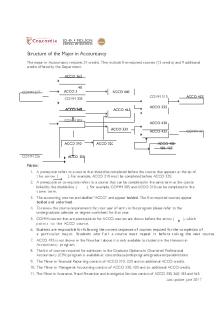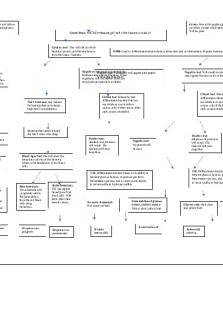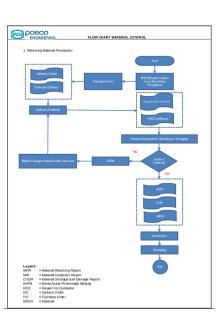Assault Flowchart PDF

| Title | Assault Flowchart |
|---|---|
| Course | Criminal Law and Procedure |
| Institution | Australian National University |
| Pages | 8 |
| File Size | 181.4 KB |
| File Type | |
| Total Downloads | 118 |
| Total Views | 167 |
Summary
Flowchart of Assault...
Description
Assault Flowchart Common Assault S 61 of Crimes Act - 61 Common assault prosecuted by indictment o Whosoever assaults any person, although not occasioning actual bodily harm, shall be liable to imprisonment for two years -
Definition of Common Assault (not defined in Crimes Act) o Fagan “An assault is any act which done intentionally or possibly recklessly which causes another person to apprehend immediate and unlawful personal violence . . . and the actual intended use of unlawful force to another person without his consent.” Ommission to act can not constitute an assault (Fagan) o Crime of basic intent (DPP v Morgan) ‘Actus reus of assault is an act which causes another person to apprehend immediate and unlawful violence. The mens rea corresponds exactly’ Also R v Connor; DPP v Majewski
Assault by use of force - AR: Did the accused cause unlawful force to be applied to the body or clothing of the victim? o A person intentionally or recklessly causes force to be applied to clothing or body of another- (Fagan) Force can be applied to clothing- ‘so intimately connected with the person that to touch the clothes is regarded as touching the person’ (R v Thomas) o Contact need not be violent (Collins v Wilcock) o Application of force must be direct- must be aimed at victim or object on which victim supported- R v Sailsbury; Commissioner of Police v Wilson; R v Sherif o Spitting can amount to unlawful force without consent (DPP v JWH) - MR: Did the accused intend to cause violent force to be applied to the victim, or were they reckless to the possibility? o 428D- intoxication cannot be taken into account o Intention Crime of basic intent (DPP v Majewski), intent to do the action which constituted the crime o Recklessness: Did the accused have actual (subjective) foresight of the possibility of unlawful force being applied to the victim? Need only foresight of the possibility (Coleman)
Don’t need to have foresight of the actual level of harm, sufficient they have foresight of some level of harm (R v Savage) (DPP v Parmenter)
Assault by threat of force - AR: Did an act (or words) or the accused caused the victim to subjectively apprehend immediate unlawful violence? o Did the victim subjectively apprehend immediate personal violence? Victim needs to be subjectively aware (Pemble) Requires victim actual subjective apprehension of threat (Wilson; Ryan) Lamb- victim didn’t understand how revolvers work, had not subjective apprehension Pointing a gun at the back of a persons head or holding a knife over a sleeping person not assault (Pemble) Act can be constituted by mere words ‘The proposition that a gesture may amount to an assault, but that words can never suffice, is unrealistic and indefensible’ Ireland; Burstow Act or threat may be made by phonecall, so long as it causes a subjective apprehension on imminent violence (Knight; Barton v Armstrong) o Even silent phonecall R v Ireland The unreasonableness of a subjective apprehension is not relevant, so long as there was a subjective apprehension (MacPherson) Must take the victim as you find them (Blaue) The actual capacity of the accused to carry out the threatened harm is irrelevant Threat using toy gun “as clear a case of assault” as could be imagined (Everingham) Provided that the victim held the belief that the threat was capable of coming to fruition (St George, Everingham, Logdon) Inversely, if victim didn’t believe apprehended violence was carried out (R v Lamb) boys didn’t understand how revolvers work o Was the apprehension of violence immediate? Victim must apprehend imminent personal violence, not violence at some time in the future (Knight) In Knight, threats made over the phone were not sufficiently immediate- ‘They were mere threats that may have been executed at any time, if at all.’ o Calls were made from appreciable distance, recipients not in any danger of immediate violence
A locked door, whilst delaying the accused, was not sufficient to prevent the threatened violence from being characterised as immediate (Beech) Requirement of immediacy may be flexible in the circumstances (Zanker) Zanker introduced notion of threat that continued to operate on the victim’s mind o ‘instilled in her mind from the moment the words were uttered and that fear was kept alive in her mind, in the continuing present, by continuing progress, with her as prisoner, towards the house where the feared sexual violence was to occur’ o The victim had no way of knowing when the threatened violence would occur, hence could apprehend it as immediate as they may have arrived at the next corner Continue to act in this manner as they continued to make progress towards the house o Is conditionality of a threat relevant? Mere fact a threat was conditional does not prevent if from constituting an assault- law draws distinction between lawful conditional threats and unlawful conditional threats (Rosza v Samuels) Rosza v Samuels- accused said I’ll cut you to bits if victim attacked him and brandished knife- was assault because threat went beyond what was reasonable in self-defence, had it not transgressed this bound it would have been a lawful threat Mens Rea: Did the accused intend the victim to apprehend immediate personal violence, or were they reckless as to the possibility? o 428D: intoxication can not be taken into account o Intention ‘AR of assault is an act which causes another person to apprehend
-
immediate and unlawful violence. The MR corresponds exactly’
o Recklessness Standard is actual foresight of possibility victim would apprehend imminent personal violence (Coleman) Inadvertence to risk is not sufficient (i.e. not inadvertent recklessness) MacPherson Did the victim consent to the assault? - The prosecution carries the burden of proving that the victim did not consent to the assault: R v Clarence (1888) 22 QBD 23,36; Woolmington v DPP - Was there implied consent?
-
-
-
-
-
-
Implied consent to everday contact occurring in society (Collins v Wilcock) o ‘and most of the physical contacts of ordinary life are not actionable because they are impliedly consented to by all who move in society and so expose themselves to the risk of bodily contact.’ o Was there hostile intent? ‘Hostile intent may convert what would otherwise be unobjectionable as an ordinary incident of social intercourse into battery at common law.’ (Boughey v The Queen) Exceptions to otherwise actionable assaults (Collins v Wilcock) o Defence of reasonable chastisement of children: see CA 1900 NSW, s 61AA o Arrest (CrimPro) o Self-defence Consent to common assault renders the act lawful: R v Donovan; R v Brown. o Consent renders act lawful Consent and “rough undisciplined horseplay” o “In those circumstances, if Gibson consented to take part in rough and undisciplined mess games involving use of force towards those involved, no assault is proved in respect of any defendant whose participation extended only to taking part in such an activity.” (R v Aitken) Other forms of consent o Sport (R v Carr) o Medical procedures o Tattoo (R v Wilson) May not be able to consent to: o some forms of ABH/GBH if beyond scope of consent: o Lergesner v Carroll (1989) 49 A Crim R 51 (Qld) o some forms of homosexual sadomasochism: o R v Brown [1992] 2 WLR 441 (even if exp group using code words etc) o some forms of heterosexual sadomasochism: o R v Emmett [1999] EWCA Crim 1710 (asphyxiation causing lack of consciousness; burning lighter fluid on breasts during panicked movements) o R v Stein (2007) 18 VR 376 (eg. when can’t communicate moment when initial consent may be withdrawn b/c gagged etc) o BUT buttocks branding for personal adornment by husband to wife was held to be consensual: R v Wilson [1996] 3 WLR 125
Aggravating Elements to Assault -
Did the assault occasion actual bodily harm (S 59)
-
o What is ABH? (R v Donovan) Given its ‘ordinary meaning’ ‘any hurt or injury calculated to interfere with the health or comfort’ ‘Need not be permanent but must, no doubt, be more than mere transient or trifling’ o Is psychiatric injury ABH? Harm must be beyond mere emotions such as fear distress or panic (R v Chan-Fook) Must be an identifiable condition (R v Chan-Fook) For ABH constituted by psychiatric injury to be made out, expert medical evidence disclosing a clinical medical condition will be required- R v Phan-Chook Factors to consider If assessment is done more than 3 days after incident (R v Lavender) o If done under 3 days, may infer it would be more likely to be transient mental states o DSM (provisional) diagnosis? o description of functional impairments? o description of clinical treatment sought or deemed necessary Did the assault occasion grievous bodily harm/wounding? o S 4 Crimes Act defintions Grievous bodily harm includes: (a) the destruction (other than in the course of a medical procedure) of the foetus of a pregnant woman, whether or not the woman suffers any other harm, and (b) any permanent or serious disfiguring of the person, and (c) any grievous bodily disease (in which case a reference to the infliction of grievous bodily harm includes a reference to causing a person to contract a grievous bodily disease). DPP v Smith: “really serious bodily injury” recognisable psychiatric illness too: Chan Fook, R v Ireland; R v Burstow Wounds any person R v Devine - Wounding is breaking through the outer (epidermis) and inner (dermis) skins and usually causes bleeding o s 33 Wounding or GBH with intent A person who: wounds any person, or AR causes grievous bodily harm to any person, AR with intent to cause grievous bodily harm to that or any other person is guilty of an offence. MR o Type of intent
Specific intent- 428B(2)(a) table Pursuant to s 428C(1)- intoxication can be taken into account in determining whether accused had MR Exceptions o However, such evidence cannot be taken into account if the person: (a) had resolved before becoming intoxicated to do the relevant conduct, or (b) became intoxicated in order to strengthen his or her resolve to do the relevant conduct. o S 35 Reckless GBH or wounding (1) Reckless grievous bodily harm—in company A person who, in the company of another person or persons: (a) causes grievous bodily harm to any person, and AR (b) is reckless as to causing actual bodily harm to that or any other person, MR is guilty of an offence. Maximum penalty: Imprisonment for 14 years. (2) Reckless grievous bodily harm A person who: (a) causes grievous bodily harm to any person, and (b) is reckless as to causing actual bodily harm to that or any other person, Recklessness o “Recklessly causes grievous bodily harm” requires foresight as to the possibility that actual bodily harm would result: o Foresight as to the possibility of a given result- Blackwell v R (at the time this case was decided foresight as to GBH was required) o Foresight of ABH- s 35(2)(b) (legislature intervened to lower the threshold of foresight)
-
-
Meaning of In company o Requires physical presence (R v Button; R v Grifen) But this is an elastic concept- “the test is the coercive effect of the group. There must be such proximity as would enable the inference that the coercive effect of the group operated, either to embolden or reassure the offender in committing the crime, or to intimidate the victim into submission” ‘…the concept does not merely relate to physical distance… but also the connection in purpose’ o Must participate by at least encouraging or assisting (R v Crozier)
o Cases R v Leoni (robbery)- group rushed into home, seperated and looked for money, appellant stayed at door, accsed aware victim knew of his presence and was in position to contribute if needed- held to be incompany -
s 58 Assault with intent to commit a serious indictable offence on certain officers o Whosoever: o assaults any person with intent to commit a serious indictable offence, or o assaults, resists, or wilfully obstructs any officer while in the execution of his or her duty, such officer being a constable, or other peace officer, custom-house officer, prison officer, sheriff’s officer, or bailiff, or any person acting in aid of such officer, or o assaults any person, with intent to resist or prevent the lawful apprehension or detainer of any person for any offence,
o s 4: definition of serious indictable offence- punishable by imprisonment for life, or for 5 years or more -
s 60 Assault and other actions against police officers o (1) A person who assaults… a police officer while in the execution of the officer’s duty, although no actual bodily harm is occasioned to the officer, is liable to imprisonment for 5 years.
-
Was the officer in the execution of their duty? o ‘A police officer acts in the execution of his duty from the moment he embarks upon a lawful task connected with his functions as a police officer, and continues to act in the execution of that duty for as long as he is engaged in pursuing the task and until it is completed, provided that he does not in the course of the task do anything outside the ambit of his duty so as to cease to be acting therein.’
Type of Assault
Relevant Sections of the Crimes Act
Common Assault
61
Level of Damage Inflicted
Not occasioning ABH or GBH
Assault Occasioning Actual Bodily Harm
59 (1)
ABH defined in R v Donovan o Seriousness of injury is ‘is more than mere transient or trifling’
Assault Occasioning Grievous Bodily Harm
33(1), 35(2), 4
GBH defined in s 4 o Permanent or serious disfiguring of the person o Grievous bodily disease o Destruction of a foetus
Assault to particular class of people
s 60
Assault and other actions against police officers
Assaults etc at schools
Assault with intent to commit a serious indictable offence on certain
s 60E Assault accompanied by a particular intention
s 58...
Similar Free PDFs

Assault Flowchart
- 8 Pages

Assault Cases
- 3 Pages

Flowchart-acco - flowchart
- 1 Pages

Flowchart
- 8 Pages

Criminal Assault
- 2 Pages

Common assault
- 4 Pages

Battery and Assault
- 2 Pages

Flowchart
- 1 Pages

Assault Battery and ABH
- 15 Pages

Chapter 29 Sexual Assault
- 9 Pages

Fagan v MPC and Assault
- 2 Pages

Assault and injuries based note
- 5 Pages

Assault - Law of Torts
- 1 Pages

Assault by penetration
- 5 Pages

Negligence Flowchart
- 3 Pages
Popular Institutions
- Tinajero National High School - Annex
- Politeknik Caltex Riau
- Yokohama City University
- SGT University
- University of Al-Qadisiyah
- Divine Word College of Vigan
- Techniek College Rotterdam
- Universidade de Santiago
- Universiti Teknologi MARA Cawangan Johor Kampus Pasir Gudang
- Poltekkes Kemenkes Yogyakarta
- Baguio City National High School
- Colegio san marcos
- preparatoria uno
- Centro de Bachillerato Tecnológico Industrial y de Servicios No. 107
- Dalian Maritime University
- Quang Trung Secondary School
- Colegio Tecnológico en Informática
- Corporación Regional de Educación Superior
- Grupo CEDVA
- Dar Al Uloom University
- Centro de Estudios Preuniversitarios de la Universidad Nacional de Ingeniería
- 上智大学
- Aakash International School, Nuna Majara
- San Felipe Neri Catholic School
- Kang Chiao International School - New Taipei City
- Misamis Occidental National High School
- Institución Educativa Escuela Normal Juan Ladrilleros
- Kolehiyo ng Pantukan
- Batanes State College
- Instituto Continental
- Sekolah Menengah Kejuruan Kesehatan Kaltara (Tarakan)
- Colegio de La Inmaculada Concepcion - Cebu
